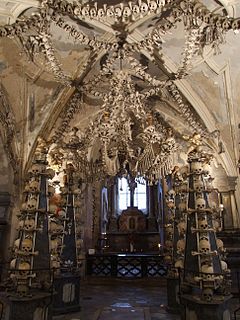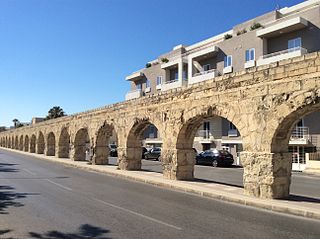
Valletta is the administrative unit and capital of Malta. Located on the main island, between Marsamxett Harbour to the west and the Grand Harbour to the east, its population within administrative limits in 2014 was 6,444. According to the data from 2020 by Eurostat, the Functional Urban Area and metropolitan region covered the whole island and has a population of 480,134. Valletta is the southernmost capital of Europe, and at just 0.61 square kilometres (0.24 sq mi), it is the European Union's smallest capital city.

The Sedlec Ossuary is a Roman Catholic chapel, located beneath the Cemetery Church of All Saints, part of the former Sedlec Abbey in Sedlec, a suburb of Kutná Hora in the Czech Republic. The ossuary is estimated to contain the skeletons of between 40,000 and 70,000 people, whose bones have, in many cases, been artistically arranged to form decorations and furnishings for the chapel. The ossuary is among the most visited tourist attractions of the Czech Republic, attracting over 200,000 visitors annually.

Fort Manoel is a star fort on Manoel Island in Gżira, Malta. It was built in the 18th century by the Order of Saint John, during the reign of Grand Master António Manoel de Vilhena, after whom it is named. Fort Manoel is located to the north west of Valletta, and commands Marsamxett Harbour and the anchorage of Sliema Creek. The fort is an example of Baroque architecture, and it was designed with both functionality and aesthetics in mind.

MUŻA is an art museum located at Auberge d'Italie in Valletta, Malta. It was formerly located at Admiralty House between 1974 and 2016, when it was known as the National Museum of Fine Arts.

The Metropolitan Cathedral of Saint Paul, commonly known as St Paul's Cathedral or the Mdina Cathedral, is a Roman Catholic cathedral in Mdina, Malta, dedicated to St. Paul the Apostle. The cathedral was founded in the 12th century, and according to tradition it stands on the site of where Roman governor Publius met St. Paul following his shipwreck on Malta. The original cathedral was severely damaged in the 1693 Sicily earthquake, so it was dismantled and rebuilt in the Baroque style to a design of the Maltese architect Lorenzo Gafà between 1696 and 1705. The cathedral is regarded as Gafà's masterpiece.

The Auberge de Castille is an auberge in Valletta, Malta. The auberge is located at Castile Place, close to Saint James Cavalier, the Malta Stock Exchange, and the Upper Barrakka Gardens. It sits at the highest point of Valletta and overlooks Floriana and the Grand Harbour area.

The Mediterranean Conference Centre is a conference centre in Valletta, Malta. The building was built as a hospital in the 16th century by the Order of St. John, and it was known as the Sacra Infermeria or the Holy Infirmary. It was known as the Grand Hôspital during the French occupation of Malta and during the British period was named as the Station Hospital.

The Wignacourt Aqueduct is a 17th-century aqueduct in Malta, which was built by the Order of Saint John to carry water from springs in Dingli and Rabat to the newly built capital city Valletta. The aqueduct was carried through underground pipes and over arched viaducts across depressions in the ground.

The Auberge d'Italie is an auberge in Valletta, Malta. It was built at various stages in the late 16th century to house knights of the Order of Saint John from the langue of Italy, and it originally had a Mannerist design by Girolamo Cassar and several other architects. The building continued to be modified throughout the course of the 17th century, with the last major renovation being carried out in the 1680s during the magistracy of Gregorio Carafa, giving the building a Baroque character.

Spinola Palace, also known as Spinola House and Villa Spinola, is a palace in St. Julian's, Malta. It was built in the 17th century by Fra Paolo Rafel Spinola, a knight of the Order of St. John, and was enlarged in the 18th century. The later construction was designed by Romano Carapecchia, which is considered a masterpiece, with its back having an elegant clock that is a unique feature to secular Baroque architecture in Malta.

The Slaves' Prison officially known as the Grand Prison and colloquially as the bagnio, was a prison in Valletta, Malta. It was established in the late 16th century, and remained in use as a prison throughout the 17th and 18th centuries. It was subsequently used as a naval hospital, a school and an examination hall. It was bombed in World War II, and the ruins were demolished to make way for a block of flats.
Andrea Belli was a Maltese architect and businessman. He designed several Baroque buildings, including Auberge de Castille in Valletta, which is now the Office of the Prime Minister of Malta.

Maltese Baroque architecture is the form of Baroque architecture that developed in Malta during the 17th and 18th centuries, when the islands were under the rule of the Order of St. John. The Baroque style was introduced in Malta in the early 17th century, possibly by the Bolognese engineer Bontadino de Bontadini during the construction of the Wignacourt Aqueduct. The style became popular in the mid to late 17th century, and it reached its peak during the 18th century, when monumental Baroque structures such as Auberge de Castille were constructed.

Emanuele Luigi Galizia was a Maltese architect and civil engineer, who designed many public buildings and several churches. He is regarded as "the principal Maltese architect throughout the second half of the nineteenth century".

Caterina Vitale (1566–1619) was the first female pharmacist and chemist in Malta, and the first female pharmacist of the Knights Hospitaller.

The 1592–1593 Malta plague epidemic was a major outbreak of plague on the island of Malta, then ruled by the Order of St John. It occurred in three waves between June 1592 and September 1593, during the second plague pandemic, and it resulted in approximately 3000 deaths, which amounted to about 11% of the population. The disease was imported to Malta by Tuscan galleys that had captured vessels from Alexandria. In 1593, the Order requested assistance from Sicily to deal with the epidemic, and the measures taken were effective in containing plague.

The statue of António Manoel de Vilhena is a life-sized Baroque bronze statue of António Manoel de Vilhena, a Portuguese Grand Master of the Order of St John. Commissioned in 1734 by the knight Felician de Savasse, it was sculpted by Pietro Paolo Troisi and cast by Aloisio Bouchut. In 1736 it was installed at Fort Manoel in Malta, and it was subsequently relocated a number of times. It was moved to Piazza Tesoreria in Valletta in 1858, to the entrance of The Mall gardens in Floriana in 1891, and to its present location at Pope John XXIII Square in Floriana in 1989.

The Chapel of St Domenica is a Roman Catholic chapel in Dingli, Malta, which is dedicated to Saint Domenica. It was built in the 17th century.

The Chapel of St Anthony of Padua is a Roman Catholic chapel located in Fort Manoel on Manoel Island in Gżira, Malta. It was completed in 1727 as an integral part of the fort, and it was partially destroyed by aerial bombardment in 1942 during World War II. The chapel was reconstructed as part of a restoration project and it was completed in 2009.

St Catherine's Monastery is a monastery in Valletta, Malta which houses cloistered nuns of the Second Order of Saint Augustine. It incorporates the Church of the Presentation of Our Lady, which is more commonly known as the Church of St Catherine. The church and monastery were built in the 18th century and they replaced a previous monastery which had been housed in a 16th-century palace.
























